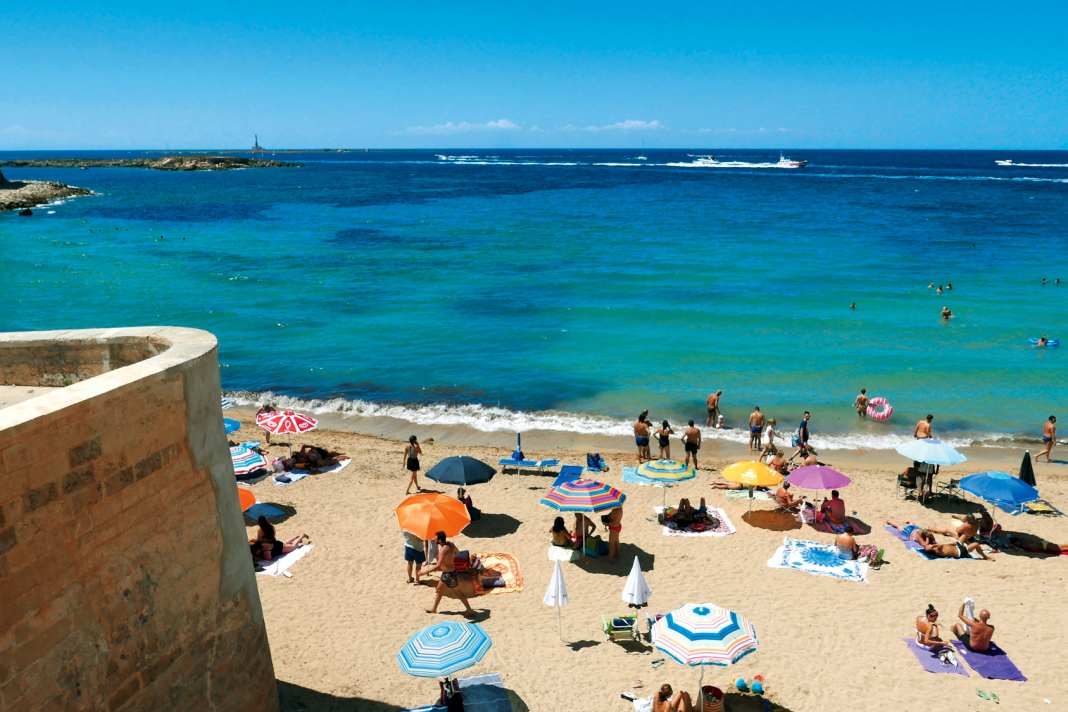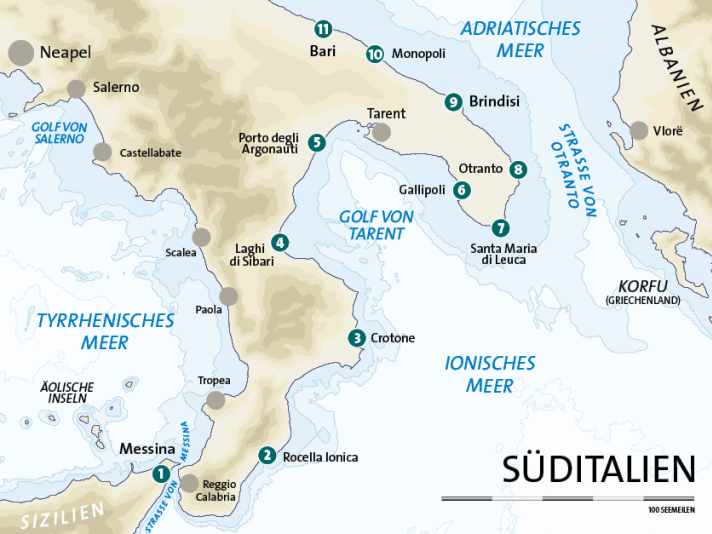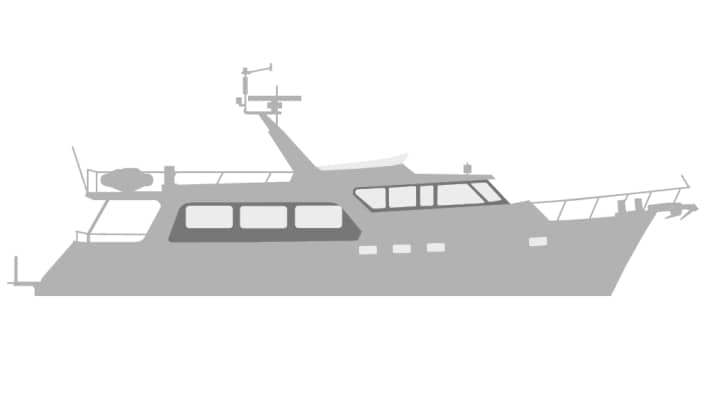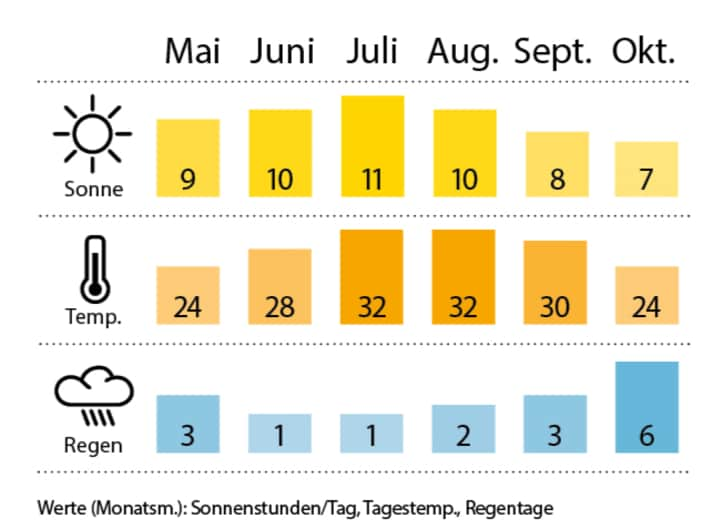





Completely new shores lie ahead of us: on the 99th day of our cruise around Italy, we leave Messina. From now on, we will sail along the mainland coast, which is completely unknown to us apart from Puglia - first around the tip of the boot, then through the Gulf of Taranto and, after rounding the heel of the boot, up the Adriatic Sea to the north. The first leg of the journey begins with increasing wind and swell, with spray blowing right up to the flybridge. But after just over seven hours, we reach our Calabrian harbour of destination, Roccella Ionica.
The sandbank in front of the harbour entrance turns out to be harmless and we are soon alongside the quay. The harbour may not win any beauty awards, but it is still used by many ships as a stopover - there are simply no viable alternatives between Messina and here. The outside temperature is still 25 to 30 degrees at night and even higher inside. As the water is at a similar temperature, there is no cooling from below. We marvel at the crews of the smaller sailing yachts, who don't have the comfort of air conditioning and have to crawl into their overheated bunks at night...
The next day we reach Crotone, where two elderly gentlemen act as "harbour masters" and form the reception committee. Here we are moored right next to the Norwegian ketch "Blåmann", a wooden two-master built to a design by the famous designer Colin Archer. Although Crotone doesn't come off well in the harbour guide, it turns out to be a lively holiday resort where the streets and restaurants are buzzing with life. Many fish shops offer fresh catches. A huge map shows the settlements once founded by the Greeks in the south of what is now Italy. Crotone - formerly Kroton - is one of them. Due to the wind forecast the next morning, we stay another night and use the day to work on the boat.
Founded by the Greeks
Laghi di Sibari is located in the westernmost corner of the Gulf of Taranto near the town of Sibari, which was also originally founded by the Greeks. The marina claims to be the largest in Italy. It is located on four artificial islands, which are built up with holiday homes and flats. Coming from the sea, you reach the interior via an extremely shallow canal, the mouth of which tends to silt up. We are asked to wait in front of the entrance for a small pilot boat to guide us through the shallows. A man stands at the bow with a long pole and takes a sounding every few metres. Then he indicates the direction. We move through the canal, which is only 1.60 metres deep at times, at a snail's pace. With our draught, there really is only the proverbial hand's breadth of water under the keel.
The marina is indeed huge and is mainly used by smaller boats. We are by far the largest steamer and wonder when the last time such a ship came here was. Unfortunately, the appearance is very dilapidated: peeling paint, broken wood and crumbling concrete. If there weren't people living, travelling and walking around here, you'd think it was about to be demolished - but that's not the case. In total contrast to this is the friendliness and helpfulness of the harbour office. When I ask about the mooring fee, I am told that the price list only goes up to 20.50 metres in length. My suggestion that I should simply upsize is met with a counter-proposal: They were happy to have such a large ship as a guest and would therefore waive the fee altogether. At first I think I've misunderstood, but that's exactly what they meant. Thank you very much - this has never happened to us before!
Life in Italy starts in the evening
After a similarly exciting trip, we head for Porto degli Argonauti the next day. Behind the euphonious name lies another artificial holiday world - but one of the very finest. The new-looking complex is home to holiday homes, a hotel and a kind of village centre - all embedded in a beautifully landscaped and meticulously maintained park. Almost silently humming and free electric vehicles connect the complex with the beach and the marina. We can't remember seeing anything better anywhere else. Only the Luv pizzeria surprises us with a strange novelty: there is no wine - instead, Bavarian beer on tap. And that in southernmost Italy... So it's not "Salute!", but "O'zapft is!"
The sultry air indicates a change in the weather. Dark storm clouds are gathering, the first gusts are whistling through the harbour and whipping up whitecaps. We first travel under land, where the water is even calmer. We read the following about our actual destination, Taranto, which gave the gulf its name: "The architectural structure of the old town in this area is currently in a disastrous state. Many houses are abandoned, in danger of collapsing or already in ruins." When the marina we are aiming for charges a hefty 400 euros per day for a berth, we decide to head straight for Gallipoli.
The original Greek name Kallipolis means "beautiful city". We are particularly fond of the old town, which is well worth seeing: it is located on an almost circular rocky island, which is connected to the more modern new town by a bridge. Gallipoli has three harbours - two small ones in the south and west with a "snuggle factor" and a larger one in the north, which, in addition to our marina, is also home to the extensive fishing fleet. The fresh catch is sold almost daily at the fish market. If you want to go for a swim and are looking for a sandy beach, the Spiaggia della Purità ("Beach of Purity") right next to the old town centre is the place for you. In front of the old town centre, there are two small, flat islands next to some reefs. The larger Isola di Sant'Andrea, in whose lee sports boats anchor, is also home to a white lighthouse that can be seen from afar.
The great heat seems to be over
After the strong winds have died down, we sail into Santa Maria di Leuca, the southernmost tip of the boot heel, in glorious weather. The large Porto Turistico is very busy. In addition to numerous local permanent residents, the harbour is used by many ships as a stopover - especially for journeys to and from Greece. The island of Corfu is only around 60 nautical miles away, and the Greek mainland is barely 20 nautical miles further. In addition to the large marina, Santa Maria di Leuca has a long seafront promenade along which many large, prestigious Art Nouveau villas have been built. The town is also the end point of a 250 kilometre long aqueduct that supplies large parts of Apulia with water. The Apulian aqueduct is the largest in Europe. The cascading overflow at the end of the pipeline is also impressive.
From now on we head north again, into the Adriatic. It is still very warm, but the extreme heat seems to be over. We are also met by a pleasantly fresh wind.
The large natural harbour of Otranto only offers berths for smaller boats in the marinas. The rest of the harbour, with a large quay suitable for us, is managed by the Guardia Costiera, which, as is usually the case, doesn't speak English. So nothing can be clarified on the phone and we simply drive there. After we have painstakingly moored our boat and are about to enter the town, the authorities approach us and make it clear that we are unfortunately not allowed to moor here. The quay is needed in the evening as a launching pad for a big fireworks display. The only alternative is to anchor.
Standstill cranes and little commercial shipping make it clear that the place has seen better times in Italy
We manage to negotiate a little grace period, which we use to visit the beautiful town. Otranto is practically built in and around a huge fortress and is bursting with life, which unfortunately we can only enjoy for a short time. Then we cast off and look for an anchorage in the spacious bay, which is only open to the east. Unfortunately, we have a light easterly wind today of all days. We are rewarded for the rocking with a magnificent firework display, which is launched directly in front of our bow and then explodes above us. The thunder of the detonations reverberates several times in the bay, creating an infernal spectacle.
In excellent conditions once again, we continue along the coast to Brindisi, which already looks a little more urban and has an airport and a huge commercial harbour. However, idle cranes and little commercial shipping make it clear that the town has seen better days. Unfortunately, the marina is a long way from the town centre and there is no beach. So you feel a bit like you're in an isolation ward and have to go to some effort to socialise. However, the harbour promenade in the old town is very attractive and particularly lively in the evenings, when, as in all southern Italian towns, life really gets going.
The wind comes up and keeps us in the harbour for a few days. When we finally set sail, the wind had died down a little, but the swell was still in full force. Not everyone's cup of tea, so we are delighted when we finally arrive in pretty Monopoli. Here, too, the Guardia Costiera manages the quay, but the office speaks English and is used to visitors like us. In principle, you are only allowed to stay one night, which we don't exceed. Monopoli is quite simply a little dream: the beautiful old town is excellently maintained and illuminated, there is a beach not far away and several small harbour basins with lots of fishing boats give the town its charm. An open-air dinner in one of the many restaurants is just as much a must as a stroll through the old town afterwards.
Back on the boat, we listen to an open-air concert from the opposite shore over a glass of wine. The next morning, we go for another swim and do some shopping. At the harbour, fishermen mend nets and roll up hook lines while a pianist plays melancholy ballads.
The marina turns out to be very well organised as Nautica Ranieri
The swell and wind are now completely gone. So we take a leisurely drive to Bari, where we have reserved a berth at Nautica Ranieri. The marina turns out to be very well organised: the form with our details is ready, as are the access cards and city map. Although we are a little way from the town centre, the nearby Marconi district also offers all kinds of options. After lunch, we stroll along the waterfront where, to our surprise, many Italian families have set up camp on the pavement. They sit on the stone balustrade, eat and drink from the folding tables they have brought with them and chat while the Bambini play late into the evening. Those who have not brought their own food are catered for by small mobile vans offering drinks and food. And above it all, the light of the San Cataldo lighthouse circles majestically.
Service

Cruising stages
S Messina-Rocella Ionica: 65 nm
- Rocella Ionica-Crotone: 64 nm
- Crotone-Laghi di Sibari: 55 nm
- Laghi di Sibari-Porto degli Argonauti: 40 nm
- Porto degli Argonauti-Tarento-Gallipoli: 60 nm
- Gallipoli-Santa Maria di Leuca: 25 nm
- Santa Maria di Leuca-Otranto: 24 nm
- Otranto-Brindisi: 41 nm
- Brindisi-Monopoli: 38 nm
- Monopoli-Bari: 26 nm
Z Bari
Total distance: 438 nm
Nautical information
The Italian south coastborders the Ionian Sea from the Strait of Messina in the west across the Gulf of Taranto to the Strait of Otranto in the east, the southern border of which is marked by a line from the southern tip of Sicily to the south-western tip of the Peloponnese peninsula. The 40 nautical mile wide Strait of Otranto between the Italian harbour town of the same name and the Albanian town of Vlorë forms the transition from the Ionian to the Adriatic Sea.

Our boat: Marlow Explorer 72 (GRP) - Length: 23.66 m - Width: 6.13 m - Draft: 1.45 m - Displacement: 63 t - Cruising speed: 10 kn - Range: 3500 nm (6 kn) - CE category: A - Engine: 2 x 1000 hp (diesel)
The TOP 3 in the district
- Gallipoli: Picturesque island location with the "beach of purity" right on the doorstep. Beats the charm factor of Taranto to the north by far
- Monopoli: Fantastic little fishing village with a picture-book old town centre. In the evening, typical Italian lifestyle in the open air
- Porto degli Argonauti: The best-equipped harbour on the Gulf of Taranto. The service and holiday offer of the holiday resort leaves nothing to be desired
Weather/climate

Literature
- Coastal handbook "Italy" by Rod Heikell. Edition Maritim, 500 p., 840 illustrations, format: 21.7 x 30.6 cm, hardcover. ISBN 978-3-667-11229-3, price: 69.90 euros. www.delius-klasing.de
- Italian pleasure craft chart sets "P5b: Mare Ionio" (Ionian Sea, 84 euros) and "P7: Adriatico Meridionale" (Southern Adriatic, 110 euros), scale 1 : 100 000 (general charts) and 1 : 30 000 (detailed charts). Available from: www.hansenautic.de

